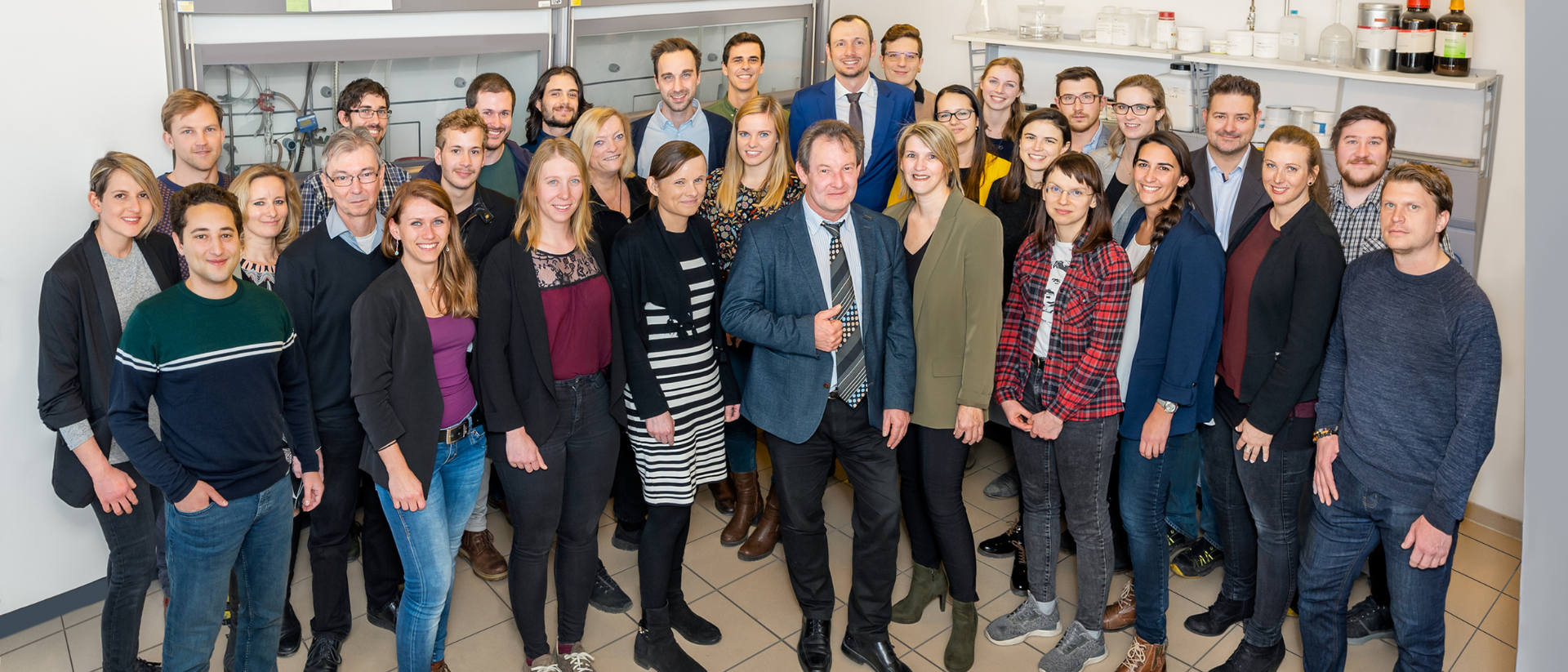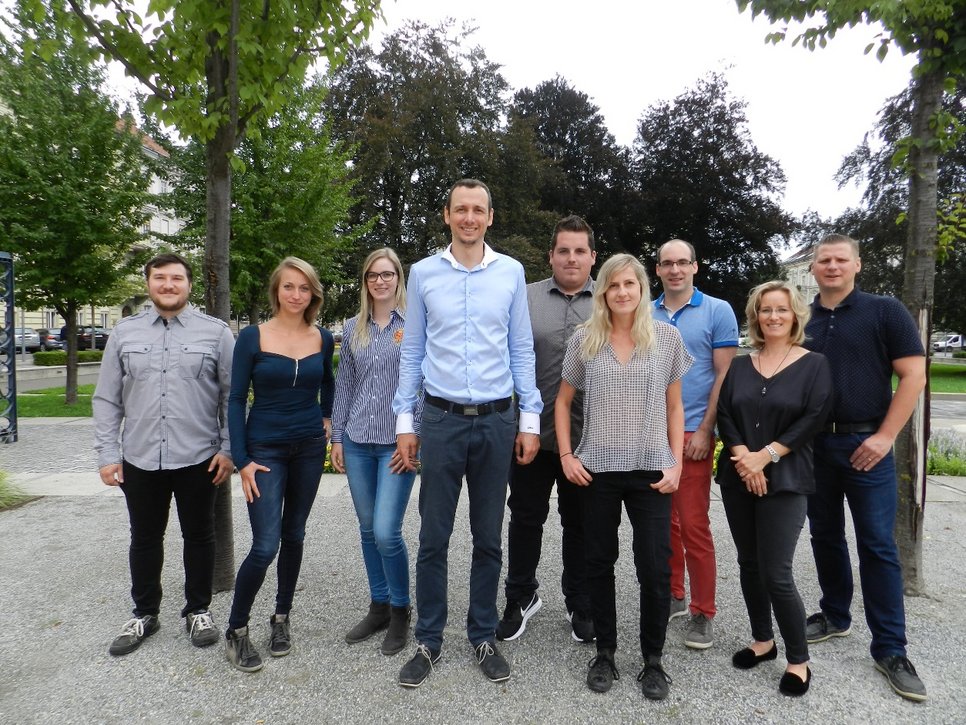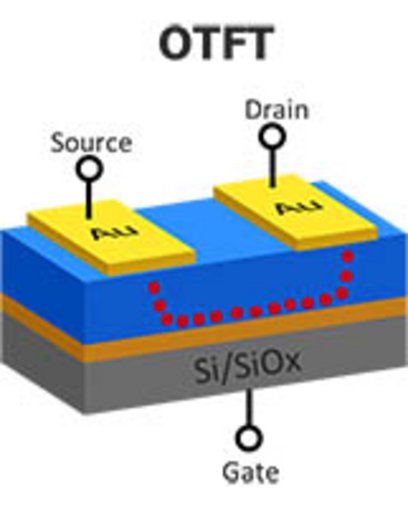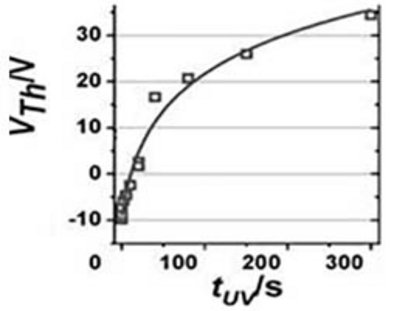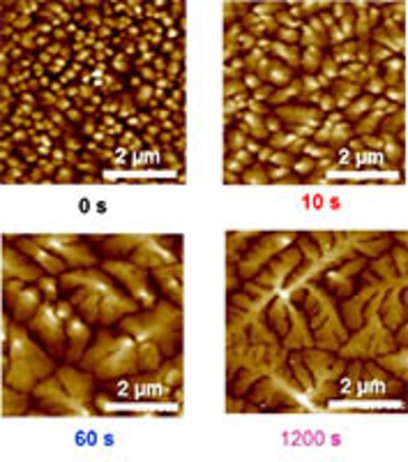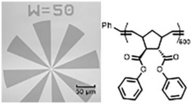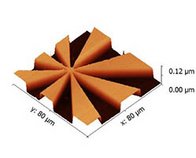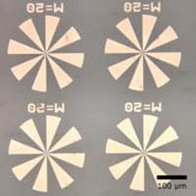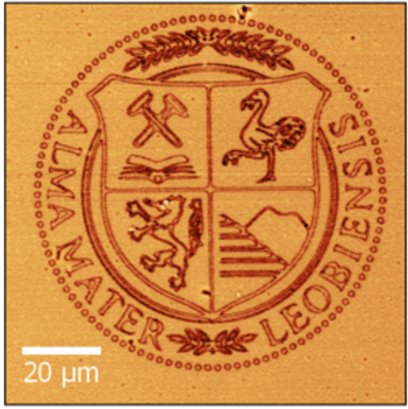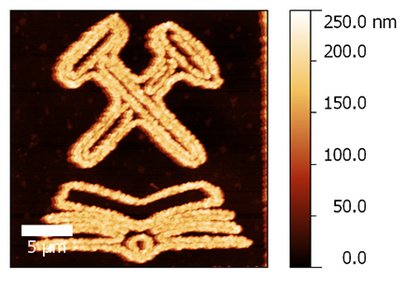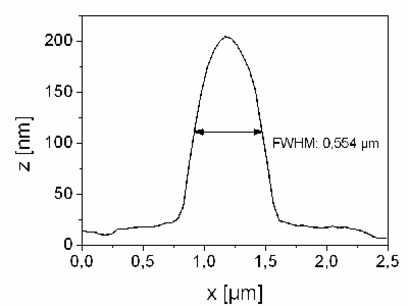Griesser Group
The group of Assoc.-Prof. Dr. Thomas Griesser focuses on the synthesis and application of photosensitive materials for optical elements, organic electronics, surface science and additive printing methods.
Assoc.-Prof. Griesser is head of the Christian Doppler Laboratory for Functional and Polymer Based Ink-Jet Inks, which deals with the investigation of biocompatible inks and resins for ink-jet und UV based 3D printing. In this context, alternative radical based curing reactions are explored on a fundamental level to substitute (meth)acrylate monomers/oligomers and to realize customized medical devices by additive manufacturing technologies. Other research topics of his group deal with the development and investigation of low-migration photoinitiators, inks/resins for stretchable electronics and optics, photosensitive materials for organic electronics as well as the micro and nanopatterning of functional surfaces.
His work has been disseminated in numerous scientific articles, book chapters and presentations at national and international conferences.
Research
The Griesser group covers a range of research fields between macromolecular chemistry, polymer photochemistry, organic electronics, photopolymerization, surface and nanoscience, and biomaterials.
Research Areas:
Biocompatible Monomers and Photopolymers
One major research field of the Griesser group deals with the development of new biocompatible resins based on Thiol-X chemistry for additive manufacturing technologies. In the last years, particularly, the thiol-yne reaction has been investigated for the 3D printing of biocompatible medical devices (e.g. clear aligners, stents and bone screws; see pictures below) by means of stereolithography. This system is characterized by a high monomer conversion (> 98%), which greatly reduces the migration of monomer residues. Significant advantages of this reaction compared to the polymerization of acrylate and methacrylate monomers are the biocompatibility of alkyne monomers, the high polymerization rate as well as the comparably high impact strength of the formed photopolymers.
3D printed medical devices:
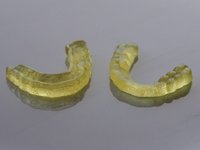
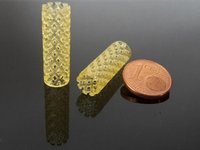
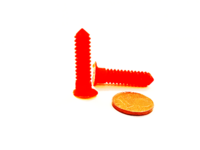
Ref: Andreas Oesterreicher, Andreas Moser, Matthias Edler, Heidi Griesser, Gerald Pinter, Sandra Schlögl, Margit Pichelmayer, Thomas Griesser. Investigating Photo-curable Thiol-yne Resins for Biomedical Materials, Macromolecular Materials and Engineering, 2017, 302, 1600450. Andreas Oesterreicher, Johannes Wiener, Meinhart Roth, Andreas Moser, Robert Gmeiner, Matthias Edler, Gerald Pinter, Thomas Griesser. Tough and degradable photopolymers derived from alkyne monomers for 3D printing of biomedical materials, Polymer Chemistry, 2016, 7, 32, 5169. Andreas Oesterreicher, Christian Gorsche, Santhosh Ayalur-Karunakaran, Andreas Moser, Matthias Edler, Gerald Pinter, Sandra Schlögl, Robert Liska, Thomas Griesser. Exploring Network Formation of Tough and Biocompatible Thiol-yne Based Photopolymers, Macromol. Rapid Commun., 2016, 37, 1701. Andreas Oesterreicher, Santhosh Ayalur-Karunakaran, Andrea Moser, Florian H. Mostegel, Matthias Edler, Petra Kaschnitz, Gerald Pinter, Gregor Trimmel, Sandra Schlögl, Thomas Griesser. Exploring thiol-yne based monomers as low cytotoxic building blocks for radical photopolymerization, Journal of Polymer Science, Part A: Polymer Chemistry, 2016, 54, 21, 3484. DOI: 10.1002/pola.28239
Stretchable Optics and Electronics
The development of stretchable optics and electronics paves the way towards an easy integration of multifunctional devices in clothing, three-dimensional surfaces of machines, human skin or polymeric materials. The research of the Griesser groups deals with the development of UV-curable inks, resins and pastes for the realization of stretchable waveguides and conductors by means of ink-jet or screen printing.
Based on this technology, electrodes as well as strain and pressure sensors are developed that can easily be structured and applied on large areas. In particular, ink-jet printing in combination with screen printing enables highly efficient and large area fabrication of stretchable sensor arrays on unconventional substrates such as textiles or polymer foils.
Ink-jet printed stretchable waveguides on PDMS substrates
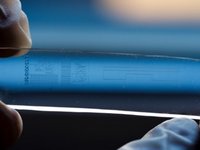
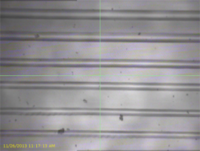
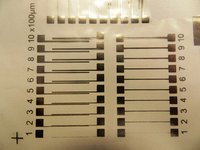
Ref: Aleksandra Samusjew, Markus Kratzer, Andreas Moser, Christian Teichert, Gerald Pinter, Krzysztof K. Krawczyk, Thomas Griesser. Inkjet printing of soft, stretchable optical waveguides through the photopolymerization of high profile linear patterns, ACS Appl. Mater. Interfaces, 2017, 9, 4941.
Photosensitive Materials for Organic Electronics
One main research topic of the Griesser Group is the investigation and development of photoreactive materials for organic electronic devices. We explore photosensitive interfacial layers in organic transistors and light emitting diodes allowing a selective modulation of the device parameters by means of UV-light. This approach has already been applied for the selective modulation of the charge charier mobility as well as the threshold voltage of Organic Thin Film Transistors.
Tuning of OTFT device parameter by photosensitive interfacial layers
Ref.: M. Marchl, M. Edler, A. Haase, A. Fian, G. Trimmel, T. Griesser, B. Stadlober, E. Zojer Tuning the Threshold Voltage in Organic Thin-Film Transistors by Local Channel Doping Using Photoreactive Interfacial Layers, Adv. Mater., 2010, 22, 5361.; M. Marchl, A. W. Golubkov, M. Edler, T. Griesser, P. Pacher, A. Haase, B. Stadlober, M. R. Belegratis, G. Trimmel, E. Zojer Photochemical control of the carrier mobility in pentacene-based organic thin-film transistors, Appl. Phys. Lett., 2010, 96, 213303.
Another research direction of the Griesser group is the development of photopatternable transistor components such as electrodes or dielectric materials paving the way towards an efficient fabrication of organic integrated circuits. In particular, photo-patternable dilectric layers are crucial for the realization of electrical interconnects for demanding organic device architectures. This research includes photo-patternable dielectric materials, which can be derived from sustainable and renewable biopolymers such as cellulose.
Photopatternable transistor components
Ref.: A. Petritz, A. Wolfberger, A. Fian, M. Irimia-Vladu, A. Haase, H. Gold, T. Rothländer, T. Griesser, B. Stadlober. Cellulose as biodegradable high-k dielectric layer in organic complementary inverters, Appl. Phys. Lett., 2013, 103, 153303; A. Petritz, A. Wolfberger, A. Fian, J. R. Krenn, T. Griesser, B. Stadlober. High performance p-type organic thin film transistors with an intrinsically photopatternable, ultrathin polymer dielectric layer, Organic Electronics, 2013, 14, 3070; A. Wolfberger, A. Petritz, A. Fian, J. Herka, V. Schmidt, B. Stadlober, R. Kargl, S. Spirk, T. Griesser. Photolithographic patterning of cellulose: a versatile dual-tone photoresist for advanced applications, Cellulose, 2015, 22, 717.
Low-migration Photoinitiators
Beside the well-documented toxicity of commonly used acrylates, also the migration of the applied photoinitiators is a non-neglectable topic. In order to overcome this limitation, the Griesser group focuses on the development of low-migration photoinitiators. One concept, which is evaluated in this context, is to derivatize commericially available photoinitiators with alkyne groups that are capable of undergoing a copolymerization reaction in thiol based formulations. Moreover, oligomeric photoinitiators are synthesized and investigated with the aim to facilitate high water-solubility together with improved migration stability. Such photoinitiators can be applied in water-borne UV-curable inks which provide several benefits compared to classical acrylate based systems, e.g. low odor, no VOCs etc.
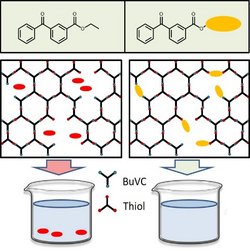
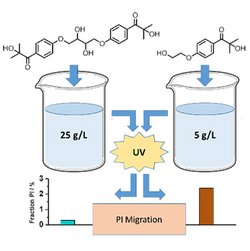
Ref: Meinhart Roth, Daniel Hennen, Andreas Oesterreicher, Florian Mostegel, Aleksandra Samusjew, Matthias Edler, Eugen Maier, Thomas Griesser. Highly Water-soluble alpha-Hydroxyalkylphenone Based Photoinitiator for Low-migration Applications, Macromol. Chem. Phys., 2017, 218, 1700022, DOI: 10.1002/macp.201700022. Meinhart Roth, Andreas Oesterreicher, Daniel Hennen, Matthias Edler, Stefan Kappaun, Florian H. Mostegel, Thomas Griesser. Exploring functionalized benzophenones as low-migration photoinitiators for vinyl carbonate/thiol formulations, European Polymer Journal, 2017, 88, 403. Andreas Oesterreicher, Meinhart Roth, Daniel Hennen, Florian H. Mostegel, Matthias Edler, Stefan Kappaun, Thomas Griesser. Low Migration Type I Photoinitiators for Biocompatible Thiol-Ene Formulations, European Polymer Journal, 2017, 88, 393.
Surface and Nanoscience
A key research topic of the Griesser Group is the micro and nanostructuring of surfaces and materials by means of photolithographic tools such as Two Photon Absoption (TPAL), Extreme UV (EUVL), UV Interference (UVIL) and Scanning Nearfield Lithography (SNL), which is mainly performed in close collaboration with external partners such as Prof. Graham Leggett (University of Sheffield, GB), Dr. Volker Schmidt (Joanneum Research Weiz, AUT) and Dr. Celestino Padeste (Paul Scherrer Institute Villigen, CH).
Examples include the nanopatterning of metal sulfides by means of EUVL. This approach provides new pathways to fabricate highly ordered structured metal sul?de layers with periodicities far below 100 nm for potential application in hybrid solar cells.
AFM and SEM images of copper indium sulfide column structures with a periodicity of 141 nm
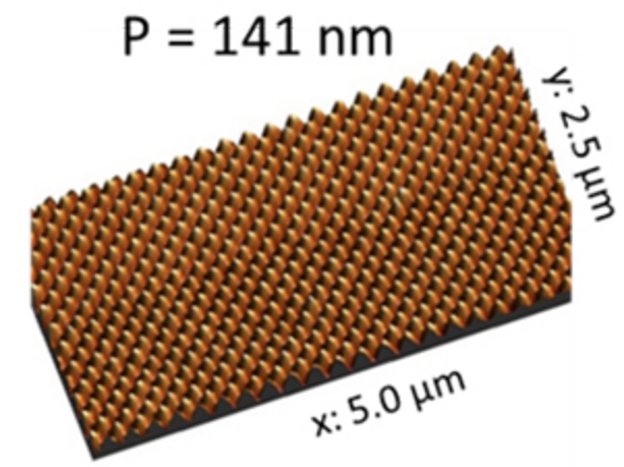

Ref: T. Rath, C. Padeste, M. Vockenhuber, C. Fradler, M. Edler, A. Reichmann, I. Letofsky-Papst, F. Hofer, Y. Ekinci, T. Griesser. Direct extreme UV-lithographic conversion of metal xanthates into nanostructured metal sulfide layers for hybrid photovoltaics, J. Mater. Chem. A, 2013, 37, 11135
Moreover, a versatile method for efficient photopatterning of polysaccharide thin films was demonstrated using the example of cellulose, the most abundant biopolymer on earth. Depending on the conditions of development (organic solvent or enzymatic treatment) either negative- or positive-type cellulose structures could be obtained, offering lateral resolutions down to the sub-µm range by means of TPAL.
AFM micrograph and line profile of photopatterned (via TPAL) cellulose films
Ref: A. Wolfberger, R. Kargl, T. Griesser, S. Spirk, Photoregeneration of Trimethylsilyl Cellulose as a Tool for Microstructuring Ultrathin Cellulose Supports. Molecules, 2014, 19, 16266; ; A. Wolfberger, A. Petritz, A. Fian, J. Herka, V. Schmidt, B. Stadlober, R. Kargl, S. Spirk, T. Griesser. Photolithographic patterning of cellulose: a versatile dual-tone photoresist for advanced applications, Cellulose, 2015, 22, 717.
The Griesser group also focusses on the micro and nanopatterning of SAMs by means of photolithography, which is used (1) to tailor and improve the properties of surfaces and (2) to realize functional nanostructures such as protein nanopatterns. Scanning Probe techniques (in close collaboration with Prof. Christian Teichert) are routinely used for the morphological characterization of patterned films.
Friction force images of photo patterned (via SNL) Self Assembled Monolayer


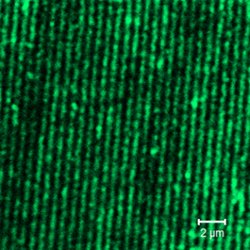
Ref: T. Höfler, A. M. Track, P. Pacher, Q. Shen, H.-G. Flesch, G. Hlawacek, G. Koller, M. G. Ramsey, R. Schennach, R. Resel, C. Teichert, W. Kern, G. Trimmel, T. Griesser; Photoreactive molecular layers containing aryl ester units: Preparation, UV patterning and post-exposure modification, Mater. Chem. Phys., 2010, 119, 287. T. Griesser, J. Adams, J. Wappel, W. Kern, G. J. Leggett, G. Trimmel; Micrometer- and nanometer scale patterning using the photo-Fries rearrangement: towards selective execution of molecular transformations with nanoscale spatial resolution, Langmuir, 2008, 24, 12420.
Current Projects
1.) CD-Laboratory for Functional and Polymer Based Ink-Jet Inks (Christian-Doppler Research Association), approx. 3.000.000 EUR, 01/2012-01/2019.
The Christian Doppler Laboratory for Functional and Polymer Based Ink-Jet Inks deals with the investigation of non-toxic, UV curable ink-jet inks for 2D and 3D printing. In this context, alternative radical based curing reactions are explored on a fundamental level to substitute (meth)acrylate monomers/oligomers in conventional resin formulations. Another research topic of the Christian-Doppler Laboratory deals with the investigation of highly efficient photoinitiators and inks for stretchable electronics and optics.
2.) CELCOS: Conductive Composite Elastomers for Low-cost Conformable Organic Sensors (FFG), 02/2015-02/2018.
The project CELCOS deals with the development of both novel conductive stretchable nano-composite materials and efficient processes for the fabrication of multifunctional sensor arrays. Approaches towards the synthesis of metallic nanoparticles in elastomeric matrices without the demand of toxic chemicals are investigated. Based on this technology, electro-mechanic organic sensors, which can be applied on stretchable surfaces such as textiles by means of additive and eco-friendly printing techniques, are being developed. In order to demonstrate the high potential of these materials and processes, the fabrication of a sensor-patch enabling the simultaneous detection of ECG parameters such as heart rate, heart rate variability as well as respiratory activity, is foreseen.
3.) Biocompatible Resins for the 3D Printing of Orthodontic Clear Aligners, AWS Prize, 02/2016-03/2018.
The aim of this project is the investigation of biocompatible monomers based on the thiol-yne reaction for the 3D printing of orthodontic clear aligners by means of stereolithography.
4.) Impact-resistant and temperature-stable photopolymers for the large-format printing of three-dimensional components, AWS Prize, 02/2017-08/2018.
This project focusses on the investigation of novel thiol based resins with the aim to obtain photopolymers with outstanding impact and heat resistance.
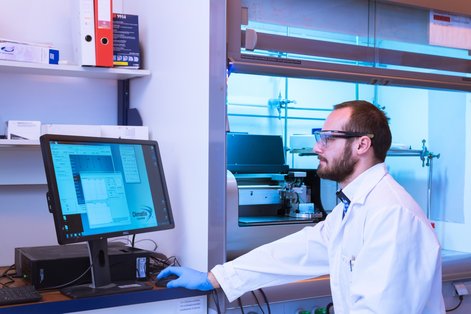
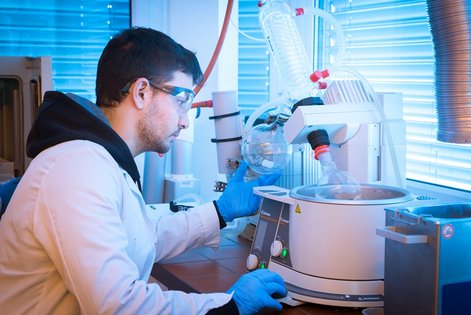
Selected Publications
The work of Univ.-Prof. Dr. Thomas Griesser and his group has been disseminated in numerous scientific articles, book chapters and presentations at national and international conferences.
- Aleksandra Samusjew, Alice Lassnig, Megan J. Cordill, Krzysztof K. Krawczyk, Thomas Griesser. Inkjet Printed Wiring Boards with Vertical Interconnect Access on Flexible, Fully Compostable Cellulose Substrates, Advanced Materials Technologies, in press, DOI: 10.1002/admt.201700250
- Aleksandra Samusjew, Markus Kratzer, Andreas Moser, Christian Teichert, Gerald Pinter, Krzysztof K. Krawczyk, Thomas Griesser. Inkjet printing of soft, stretchable optical waveguides through the photopolymerization of high profile linear patterns, ACS Appl. Mater. Interfaces, 2017, 9, 4941. DOI: 10.1021/acsami.6b13272
- Andreas Oesterreicher, Johannes Wiener, Meinhart Roth, Andreas Moser, Robert Gmeiner, Matthias Edler, Gerald Pinter, Thomas Griesser. Tough and degradable photopolymers derived from alkyne monomers for 3D printing of biomedical materials, Polymer Chemistry, 2016, 7, 32, 5169. DOI: 10.1039/C6PY01132B
- Andreas Oesterreicher, Christian Gorsche, Santhosh Ayalur-Karunakaran, Andreas Moser, Matthias Edler, Gerald Pinter, Sandra Schlögl, Robert Liska, Thomas Griesser. Exploring Network Formation of Tough and Biocompatible Thiol-yne Based Photopolymers, Macromol. Rapid Commun., 2016, 37, 1701. DOI: 10.1002/marc.201600369
- Andreas Petritz, Archim Wolfberger, Alexander Fian, Thomas Griesser, Mihai Irimia-Vladu, Barbara Stadlober. Cellulose-Derivative-Based Gate Dielectric for High-Performance Organic Complementary Inverters. Advanced Materials, 2015, 27, 7645-7656. DOI 10.1002/adma.201404627
- Matthias Edler, Stefan Mayrbrugger, Alexander Fian, Gregor Trimmel, Simone Radl, Wolfgang Kern, Thomas Griesser. Wavelength Selective Refractive Index Modulation in a ROMP Derived Polymer Bearing Phenyl- and ortho-Nitrobenzyl Ester Groups, J. Mater. Chem. C., 2013, 1, 3931. DOI: 10.1039/C3TC00006K
- Thomas Griesser, Archim Wolfberger, Ute Daschiel, Volker Schmidt, Alexander Fian, Abdellatif Jerrar, Christian Teichert, Wolfgang Kern. Cross-linking of ROMP derived Polymers Using the Two-Photon Induced Thiol-Ene Reaction: Towards the Fabrication of 3D- Polymer Microstructures, Polym. Chem., 2013, 4, 1708. DOI 10.1039/C2PY21002A
- Thomas Griesser, Simone V. Radl, Andreas Pavitschitz, Christian Teichert, Matthias Edler, Thomas Koepplmayr, Thomas Rath, Gregor Trimmel, Günther Schwabegger, Clemens Simbrunner, Helmut Sitter, Wolfgang Kern. Patterned Modulation of the Conductivity of Polyaniline by Means of Photolithography, J. Mater. Chem., 2012, 22, 2922. DOI 10.1039/C1JM14100G
- Archim Wolfberger, Barbara Rupp, Wolfgang Kern, Thomas Griesser, Christian Slugovc. Ring Opening Methathesis Polymerisation Derived Polymers as Photoresists: Making Use of Thiol-ene Chemistry, Macromol. Rapid Comm., 2011, 32, 518. DOI 10.1002/marc.201000698
- Thomas Köpplmayr, Masimiliano Cardinale, Georg Jakopic, Gregor Trimmel, Wolfgang Kern, Thomas Griesser. Photosensitive Polymers bearing Fully Aromatic Esters for Multilayer Data Storage Devices, J. Mater Chem., 2011, 21, 2965. DOI 10.1039/C0JM03575K
- Marco Marchl, Matthias Edler, Anja Haase, Alexander Fian, Gregor Trimmel, Thomas Griesser, Barbara Stadlober, Egbert Zojer. Tuning the Threshold Voltage in Organic Thin-Film Transistors by Local Channel Doping Using Photoreactive Interfacial Layers, Adv. Mater., 2010, 22, 5361. DOI 10.1002/adma.201002912
- Thomas Griesser, Thomas Höfler, Gregor Jakopic, Manuela Belzik, Wolfgang Kern, Gregor Trimmel. Refractive Index Modulation in Polymers Bearing Photoreactive Phenyl and Naphthyl Ester Units Using Different UV Wavelengths, J. Mater. Chem., 2009, 19, 4557. DOI 10.1039/B903410B
